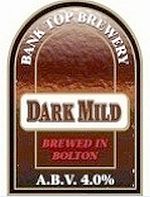- Mild ale
-
Mild ale is a low-gravity beer, or beer with a predominantly malty palate, that originated in Britain in the 17th century or earlier. Modern mild ales are mainly dark coloured with an abv of 3% to 3.6%, though there are lighter hued examples, as well as stronger examples reaching 6% abv and higher.
The term mild originally meant young beer or ale as opposed to "stale" aged beer or ale with its resulting "tang". In more recent times it has been interpreted as denoting "mildly hopped".
Light mild is generally similar, but pale in colour. There is some overlap between the weakest styles of bitter and light mild, with the term AK being used to refer to both.[1] The designation of such beers as "bitter" or "mild" has tended to change with fashion. A good example is McMullen's AK, which was re-badged as a bitter after decades as a light mild. AK - a very common beer name in the 19th century - was often referred to as a "mild bitter beer" interpreting "mild" as "unaged".
Once sold in every pub, mild experienced a catastrophic fall in popularity after the 1960s and was in danger of completely disappearing. However, in recent years the explosion of microbreweries has led to a modest renaissance and an increasing number of milds (sometimes labelled 'Dark') are now being brewed.
The Campaign for Real Ale has designated May as "Mild Month".
Contents
History
"Mild" was originally used to designate any beer which was young, fresh or unaged and did not refer to a specific style of beer. Thus there was Mild Ale but also Mild Porter and even Mild Bitter Beer. These young beers were often blended with aged "stale" beer to improve their flavour. As the 19th century progressed and public taste moved away from the aged taste, unblended young beer, mostly in the form of Mild Ale or Light Bitter Beer, began to dominate the market.
In the 19th century a typical brewery produced three or four mild ales, usually designated by a number of X's, the weakest being X, the strongest XXXX. They were considerably stronger than the milds of today, with the gravity ranging from around 1.055 to 1.072 (about 5.5% to 7% abv). Gravities dropped throughout the late 19th century and by 1914 the weakest milds were down to about 1.045, still considerably stronger than modern versions.
The draconian measures applied to the brewing industry during the First World War had a particularly dramatic effect upon mild. As the biggest-selling beer, it suffered the largest cut in gravity when breweries had to limit the average OG of their beer to 1.030. In order to be able to produce some stronger beer - which was exempt from price controls and thus more profitable - mild was reduced to 1.025 or lower.
Modern dark mild varies from dark amber to near-black in colour and is very light-bodied. Its flavour is dominated by malt, sometimes with roasty notes derived from the use of black malt, with a subdued hop character, though there are some quite bitter examples. Most are in the range 1.030-1.036 (3-3.6% abv).
Light mild is generally similar, but paler in colour. Some dark milds are created by the addition of caramel to a pale beer.
Until the 1950s, mild was the largest selling ale. It retains some popularity in the West Midlands, Wales and North West England, but has been totally ousted by bitter and lager in the South of England.[2] In 2002, only 1.3% of beer sold in pubs was Mild.[3] Mild's popularity in Wales, in particular, persisted as a relatively low-alcohol, sweet drink for coal miners. Outside the United Kingdom, Mild is virtually unknown, with the exception of Old in New South Wales and some microbrewery recreations in North America and Scandinavia.
Brown and Mild
A popular drink in the West Midlands, 'Brown and Mild' (or alternatively, 'Black and Tan') is a mix of half a pint of mild and a bottle of Brown Ale in a pint glass. In the North West of England a mixture of half a pint of mild and half a pint of bitter is known as a 'mixed'.
Brewing
Mild ales are generally based on mild malt or pale malt. Most milds contain, in addition, a quantity of crystal malt; dark milds, meanwhile, make use of chocolate malt, black malt or dark brewing sugars. Milds tend to be lightly hopped compared to pale ale and are usually low in alcohol; strong mild ales used to reach six or seven per cent abv, but very few such beers are still brewed. Sarah Hughes Dark Ruby Mild, brewed to a pre-WWI recipe, is a rare example of a strong Mild (6.0% ABV).
See also
- Beer styles
References
- ^ Martyn Cornell on AK
- ^ Good Beer Guide 2006, ISBN 1-85249-211-2, p28
- ^ Statistical Handbook 2003, British Beer and Pub Association, ISSN 1475-3545, page 21
External links
Beer styles Beer in the United Kingdom Barley wine · Bitter · Brown ale · India Pale Ale · Mild ale · Old ale · Porter · Scotch ale · StoutBeer in Belgium Beer in Germany Altbier · Berliner Weisse · Bock · Dortmunder Export · Dunkel · Gose · Pale lager · Kellerbier · Kölsch · Märzen · Roggenbier · Schwarzbier · Smoked beer · Wheat beerBeer in the United States Other See also Categories:- Beer styles
- Beer and breweries in the United Kingdom
- Types of beer
Wikimedia Foundation. 2010.

